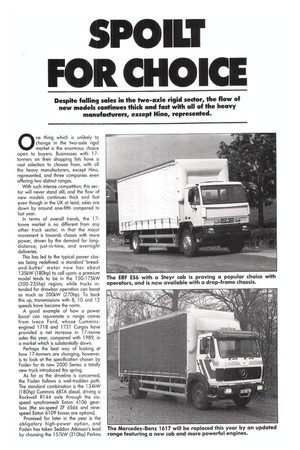SPOILT FOR CHOICE Despite falling sales in the two-axle rigid
Page 46

Page 47

If you've noticed an error in this article please click here to report it so we can fix it.
sector, the flow of new models continues thick and fast with all of the heavy manufacturers, except Hino, represented.
One thing which is unlikely to change in the two-axle rigid market is the enormous choice open to buyers. Businesses with 17tanners on their shopping lists have a vast selection to choose from, with all the heavy manufacturers, except Hino, represented, and three companies even offering two distinct ranges.
With such intense competition, this sector will never stand still, and the flow of new models continues thick and fast even though in the UK at least, sales are down by around one-fifth compared to last year.
In terms of overall trends, the 17tonne market is no different from any other truck sector, in that the major movement is towards chassis with more power, driven by the demand for longdistance, just-in-time, and overnight deliveries.
This has led to the typical power classes being redefined: a standard 'breadand-butter' motor now has about 135kW (180hp) to call upon; a premium model tends to be in the 150-175kW (200-235hp) region; while trucks intended for drawbar operation can boast as much as 200kW (270hp). To back this up, transmissions with 8, 10 and 12 speeds have become the norm.
A good example of how a power boost can rejuvenate a range comes from Iveco Ford, whose Cumminsengined 1718 and 1721 Cargos have provided a net increase in 17-tonne sales this year, compared with 1989, in a market which is substantially down.
Perhaps the best way of looking at how 17-tonners are changing, however, is to look at the specification chosen by Foden for its new 2000 Series: a totally new truck introduced this spring.
As far as the driveline is concerned, the Foden follows a well-trodden path. The standard combination is the 134kW (180hp) Cummins 6BTA diesel, driving a Rockwell R144 axle through the sixspeed synchromesh Eaton 4106 gearbox (the six-speed ZF 6566 and ninespeed Eaton 6109 boxes are options).
Promised for later in the year is the obligatory high-power option, and Foden has taken Seddon Atkinson's lead by choosing the 157kW (210hp) Perkins Phaser 210Ti rather than the Cummins B or C Series units which could have done the same job.
With a 7.1-tonne GKN front axle and the 10.5 tonne drive axle, Foden has provided operators with a 600kg loading tolerance not always found on some competitors; with the slim composite cab, and a lightweight chassis, the company has also achieved competitive body/ payload allowances as high as 12.3 tonnes.
Other features of the 2000 Series include the choice of five chassis lengths from 4.0m to 6.2m, the option of rear air-suspension with a raise/lower facility, and the availability of a sleeper cab with rest bunk.
One of the first new challengers to the Foden will be Renault's updated G range. The company currently offers the G170, but this is about to be replaced by a two-pronged attack from the G200 and the G2301-1.
Though the G range cab has received an external and internal facelift, most interest will centre around the new drivelines, based on Renault's MIDR 06.02.26 charge-cooled diesel. The version in the 0200 produces 144kW (196hp) and 635Nm (468Ibft), and is claimed to be lighter, more powerful and more economical than its predecessor, the G170.
For the G230TI, the unit is tuned to put out 166kW (226hp) and 825Nrn (608Ibft), with Renault throwing down the gauntlet to rival manufacturers by boasting that this represents the highest torque peak and the best torque/litre output in its class. Whether this engine and the other detail improvements on the G series can boost the company's rather modest share of the 17-tonne market, however, still remains to be seen.
One manufacturer with fewer problems in the two-axle market is MercedesBenz, which will be hoping to improve on its third place position this autumn with the launch at the Birmingham Motor Show of the 1 71 7 and 1720 trucks which take over from the successful 1617.
The main change is the adoption of a more modern cab derived from the SK design used on the Powerliner 2 tractive units, though with the move to higher power ratings, the charge-cooled 149kW (200hp) 1 720 will undoubtedly help Mercedes maintain its sales volume.
If choice comes into it, however, the domestic manufacturer best-placed to gain sales is ERF, which has just finished revising its 17-tonne line-up. The Steyrcabbed ES6.180 is the lighter option, and is now available with a drop-frame chassis, while the ERF cab on the E6 and E8 now comes with a choice of three ratings for solo-rigid operation, with the Cummins B series in the E6.180 and [6.210, and the C series in the more torquey E8.211.
There will almost certainly be even more choice by the end of the year. In any event, the battle for the rigid market is clearly going to be an exciting one.




































































































